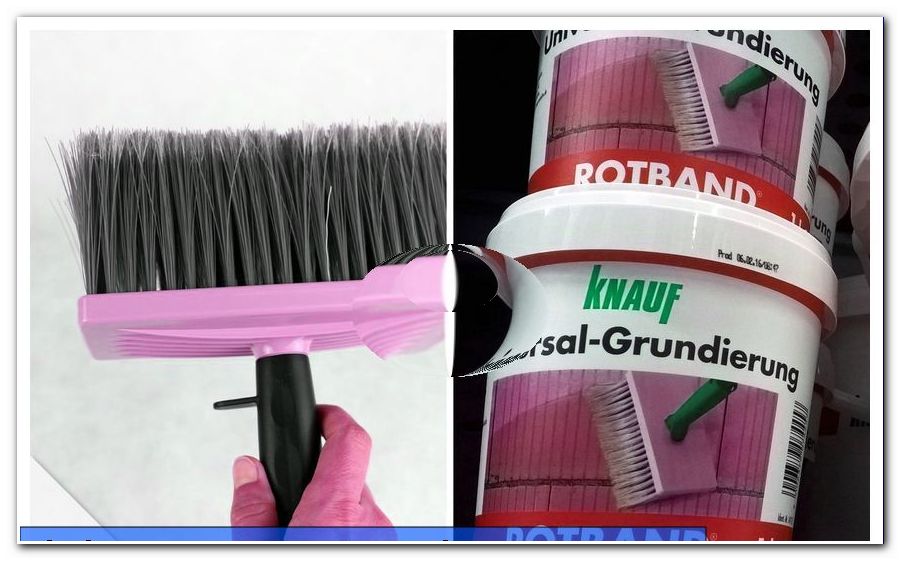Knit stole / shawl - free instructions for beginners

- Preparation and material
- Knitting pattern - stole
- Knit sturdy edge
- Different variants of the stole
A shawl or a stole is more than a decorative accessory. Both are the perfect shoulder warmers for cooler days. How often do you sit outdoors or go for a walk and change the weather from one minute to the next? These are the moments when you are looking for something warm. And here comes the shawl or a stole just right. We show with a simple knitting pattern how even beginners can knit a shawl.
The yarn determines the character of the shawl
Depending on the yarn with which you will knit this stole, it will be a warm accessory or a cozy blanket for cozy evenings. According to the following knitting instructions you can use a stronger wool as well as a thin yarn. Our shawl has a lot of similarities to the famous hay towel, which is mainly knitted from sock wool remnants. Anything that pleases is allowed with this cloth. So you can knit a colorful shawl from all your wool rests, or you decide for a more noble part. Our featured cloth is very easy to knit, so that even beginners handle it well.
Preparation and material
This shawl has a special knitting technique. We start with this cloth in the middle of the shoulder, more precisely on the cervical vertebra and work our way to a triangle. That is, the triangle is formed by the mean and outer increases of the stitches. Simple but very impressive. If at the beginning you can not tell where the journey is going, you will see after a few knitted needles that an interestingly knitted cloth is created. And the beauty of it is that this knitting technique allows so many variations that you can re-embroider for every occasion and every mood. And in the process, nothing has to be changed about the technology itself; it is the wool that makes this cloth a new and special feature.
We opted for a fine ribbon yarn, a cotton-viscose blend. Its light luster gives this yarn a noble character. The ribbon is only 3 mm wide, so it is like normal wool to knit.

You need this for a shawl:
- 400 grams of cotton ribbon yarn
- Circular needle with a long rope
- big darning needle
- possibly a stitch marker
The needle size decides the stitch strength
The knitting needles strength depends on the wool size you will knit to this triangle scarf. On each yarn banderole you will always find an exact indication.
If you knit more loosely, then the needle size may be slightly smaller. But if you knit rather tight, then you can choose an entire number upwards.
Needle size is also crucial to how loose your triangle scarf should fall. The larger the needle size, the larger the stitches become.
We have decided on this ribbon yarn, which is 3 mm wide, for a needle size No. 5.
Tip: When buying the right circular needle, make sure that it has a sufficiently long rope. If the rope is too short, you have too much knitting on the rope. That can be very difficult to knit. The rope should be at least 80 cm long.

Tip: You can easily make a stitch marker yourself. Take a slightly thicker and different colored yarn and knot it as in the picture. This stitch marker is simply knitted as an aid. He only moves from the left needle to the right needle during knitting.
A short introduction in the fast passage
Our triangular scarf has a shoulder width of approx. 1.60 meters and a mean length of approx. 80 cm.
This cloth is knitted in the pattern on the crotch right. This pattern consists only of right-hand stitches. In other words, only right stitches are knitted in the back and the back row.
The increased stitches are knitted as an envelope. Simply put a thread on the right needle and continue to knit as normal. In the back row, this thread is knitted as a right stitch. This increase results in a friendly hole pattern at the same time.
If you do not want this hole pattern, the increase without a hole is described at the end of the knitting instructions.
The edges are knitted only as a right stitch. Both the last stitch and the first stitch. This results in a clean and even edge. In this case, the thread is placed under the needle to the rear in the front row of the edge stitch. This then results in this small nodule pattern, which can also be seen in the picture.

Knitting pattern - stole
1st row: Start with five stitches at the beginning.

2nd row: Knit these as right stitches, also the edge stitches.

Now the rows begin with the increase:
3rd row: Now make a border stitch (knit on the right), envelope, a right stitch, envelope - now put the stitch marker - a right stitch, an envelope, a right stitch, an envelope, a right stitch (this last stitch is an edge stitch) knitted.
Tip: The stitch marker always sits in front of the middle stitch. That is, when you come to this marker, always knit an envelope, knit the middle stitch on the right, and knit an envelope again immediately. This will give you an always consistent center stitch, which is framed by a hole pattern.
4th row: one right edge stitch, then all stitches, as well as the envelopes - knit right.
5th row: Then knit a right edge stitch, a stitch right, an envelope, two stitches on the right (you now come to your stitch marker, now you just lay on your right needle), envelope, a right stitch, an envelope, two stitches on the right, Envelope, one stitch on the right, one right edge stitch.
6th row: Then knit all stitches to the right.
Row 7: Then knit a right edge stitch, a right stitch, an envelope, four right stitches (put the stitch marker back on the right needle), an envelope, a right stitch, an envelope, four right stitches, an envelope, a right stitch, one right edge stitch.
8th row: knit all stitches right again.
9. Row: Now make a right edge stitch, a stitch on the right, an envelope, six stitches on the right (lift the stitch marker on the right needle), envelope, one stitch on the right, envelope, six stitches on the right, cover, one stitch on the right, one right edge stitch knitted.
10th row: Now knit all stitches on the right again.

11th row: one right edge stitch, one stitch on the right, turn-up, eight stitches on the right (lift the stitch marker on the right needle), cover, one stitch on the right, cover, eight stitches on the right, cover, one stitch on the right, one right edge stitch.

12th row: Knitt all stitches on the right again.
If you now look at your knitting work, you already recognize the pattern and technique of this triangular scarf.
Your edge stitches become the width of the shawl, the part you put over your shoulders. And by the increases in the middle of the cloth, a pattern repeat is created, which divides the right and the left side of the cloth by a pattern of holes left and right next to the middle stitch. Both sides taper towards each other.

From the 13th row continue to knit as you knit the previous rounds:
- edge stitch
- right stitch
- envelope
- right stitches to the stitch marker
- envelope
- right stitches to the penultimate stitch
- envelope
- right stitch
- edge stitch
In this order, knit the entire shawl to the size you imagined. Finish the knitting work with a row of right stitches.

Then chain the last row very loosely:
- 2 stitches on the right
- 1. Lift the stitch over the 2nd stitch
- 1 stitch on the right
- 1. Lift the stitch over the 2nd stitch.
This is how you proceed to the last stitch. Now cut the thread to a length of 20 cm and simply pull the last stitch through with the thread. Then sew all the threads.

Your shawl is ready!
Knit sturdy edge
If you want a more stable border, chain the last row like this:
Take the second end of the yarn thread from your ball of wool. Every ball has two ends. One end is always on the outside of the ball of yarn and one end is the yarn beginning, which lies in the middle of the ball. With a bit of feeling, it can be easily taken out. Add this second thread to your work thread, you knit this weight loss line with two threads. Both yarn threads lie over your thread finger. It creates a very clean and stable Abkettreihe.

Different variants of the stole
Such a shawl can now be knit in a variety of designs. Try it with another yarn. Here is an example with a cotton yarn, where the yarn shows a very nice color gradient. This alone creates a completely new character of this shawl.
In this example, we have also incorporated a small pattern. In loose sequence here are next to the curled right pattern a few rows smooth right installed. You only knit the back rows that you usually knit on the right, with left stitches. Simple, but with great effect.

You can also knit a stole for your evening wear. You may also choose a silver-colored polyester yarn that has a sequin bobbin thread.
For the cold days, of course, a noble merino wool is recommended. This yarn not only warms, it turns the shawl into a cuddle cloth.
Shawl with hole pattern
So that even knit beginners get a really good sense of achievement when knitting this shawl, we show you how to knit in a small hole pattern. If you want, you can thread a matching satin ribbon through this pattern.

For this you should, as can be seen in the picture, repeatedly knit a few rows of smooth right. That is, knit right stitches on the side of the increase and knit left stitches on the back row.
Knit the hole pattern row as follows:
1. 1 edge stitch
2. 1 right stitch
3. 1 envelope
4. 1 right stitch
5. 1 envelope
6. Lift off 1 stitch
7. Knit 1 stitch on the right
8. Lift the lifted stitch over the knitted right stitch
9. 1 right stitch
10. 1 envelope
11. Lift off 1 stitch
12. Knit 1 stitch on the right
13. Lift the lifted stitch over the knitted right stitch.
Follow steps 4 to 13 over the entire course. In the back row, knit all the stitches left.
Stole with invisible mesh increase
Not every shawl wearer likes to have knitted holes in her scarf. Therefore, we will show you how to knit a stitch increase without causing holes.
In this type of increase, a new stitch is not knit by an envelope. For this, the transverse thread from the previous row is lifted onto the left needle and knitted immediately to the right. The increase is not visible.

Here we have another free knitting pattern for a self-knitted shawl to choose from: knit shawl
We wish you a lot of joy when reworking and wearing this shawl!




